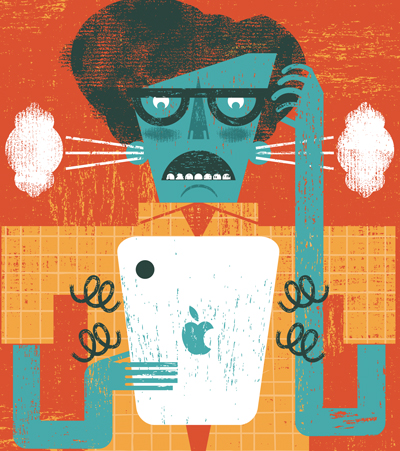IT Does Not Love iPads
Students and faculty may love them, but IT personnel get a major headache when they try to integrate Apple tablets--and the company's TV technology--in an enterprise setting.

Illustration by Matthew Daley |
Is there a higher ed institution in the United States that has not fallen into a swoon over iPads? Some colleges hand them out by the thousands to their entire student body. Others stockpile hundreds for use by faculty, staff, and administrators, or to be checked out of the library by students. On many campuses, iPads have taken over the hearts and minds of everyone.
Everyone, that is, except the IT department.
These sexy tablets might be the apple of faculty and students' eyes, but for IT directors and their staffs, working with iPads in an enterprise network environment is not the stuff of a love affair.
To state the problem simply: iPads are designed for consumer use, and as such, they're not set up for large-scale implementations. They're not even set up for two users to share the same device, much less for sharing over a network. For schools making a major investment in iPads on campus, the solution is a combination of new policies and investment in third-party tools for managing the devices.
For many other institutions, though, the devices are acquired as needed, or in small batches for specific purposes. In such cases, schools don't necessarily anticipate the additional tools and administration the iOS devices can require--until IT starts bumping up against the limitations of a device that's not easily managed under the school's existing network and resource management infrastructure. The differences between iPad device administration and that of desktop machines or laptops are apparent at all stages of their use, beginning the moment the machines arrive on campus.
Boxing Day
Take, for example, the case of Seton Hill University, a school that has distinguished itself as a forerunner in campus iPad implementations, including being named a second time as an Apple Distinguished Program. In the spring of 2010, the Greensburg, PA, school ordered 1,850 iPads in anticipation of providing them to students for the following fall term. What IT faced was a giant pallet of the devices, individually wrapped or in boxes of 10. Phil Komarny, Seton Hill's vice president for information technology and CIO, says that his staff had to take each iPad out of the box, update the operating system to the most recent version, image tag it, and put it back in the box to be ready for deployment.
"There was nothing else we could do, because this device that they built is completely consumer," Komarny shrugs.
Thomas Hoover, associate vice chancellor and CIO at the University of Tennessee at Chattanooga (UTC), had a similar experience with iPads in a previous role at Pepperdine University (CA), where the IT group handed out several hundred of the devices to students, who turned them back in at the end of the year. "We'd have to manually go through and redo all the iPads," Hoover explains. "It's not like a computer device that you can configure automatically."
Two years after the first Seton Hill deployment, Apple brought out Apple Configurator, a free download from the Mac App Store that can be used to configure 30 devices at once. But for many campus CIOs, that's too little too late. Those with big iPad implementations tend to rely on mobile-device management (MDM) applications like MobileIron that enable enterprise-level configuration, security, and app management.